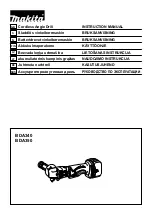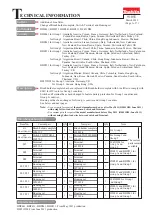
GENERAL SAFETY RULES - FOR ALL BATTERY OPERATED TOOLS
WARNING! READ AND UNDERSTAND ALL INSTRUCTIONS
.
Failure to follow all instructions listed below, may result in electric shock, fire and/or serious
personal injury.
SAVE THESE INSTRUCTIONS
Work Area
•
Keep your work area clean and well lit.
Cluttered benches and dark areas invite accidents.
• Do not operate power tools in explosive atmospheres, such as in the presence of flammable
liquids, gases, or dust.
Power tools create sparks which may ignite the dust or fumes.
• Keep bystanders, children, and visitors away while operating a power tool.
Distractions can
cause you to lose control.
Electrical Safety
• Do not abuse the cord. Never use the cord to carry the tool. Keep cord away from heat, oil,
sharp edges or moving parts. Replace damaged cords immediately.
Damaged cords may
create a fire.
• A battery operated tool with integral batteries or a separate battery pack must be recharged
only with the specified charger for the battery.
A charger that may be suitable for one type of
battery may create a risk of fire when used with another battery.
• Use battery operated tool only with specifically designated battery pack.
Use of any other
batteries may create a risk of fire.
Personal Safety
• Stay alert, watch what you are doing and use common sense when operating a power tool.
Do not use tool while tired or under the influence of drugs, alcohol, or medication.
A moment
of inattention while operating power tools may result in serious personal injury,
• Dress properly. Do not wear loose clothing or jewelry. Contain long hair. Keep your hair,
clothing, and gloves away from moving parts.
Loose clothes, jewelry, or long hair can be
caught in moving parts.
• Avoid accidental starting. Be sure switch is in the locked or off position before inserting
battery pack.
Carrying tools with your finger on the switch or inserting the battery pack into a
tool with the switch on invites accidents.
• Remove adjusting keys or wrenches before turning the tool on.
A wrench or a key that is left
attached to a rotating part of the tool may result in personal injury.
• Do not overreach. Keep proper footing and balance at all times.
Proper footing and balance
enable better control of the tool in unexpected situations.
• Use safety equipment. Always wear eye protection.
Dust mask, non-skid safety shoes, hard hat,
or hearing protection must be used for appropriate conditions.
Tool Use and Care
• Use clamps or other practical way to secure and support the workpiece to a stable platform.
Holding the work by hand or against your body is unstable and may lead to loss of control.
• Do not force tool. Use the correct tool for your application.
The correct tool will do the job better
and safer at the rate for which it is designed.
• Do not use tool if switch does not turn it on or off.
A tool that cannot be controlled with the
switch is dangerous and must be repaired.
• Disconnect battery pack from tool or place the switch in the locked or off position before
making any adjustments, changing accessories, or storing the tool.
Such preventive safety
measures reduce the risk of starting the tool accidentally.
• Store idle tools out of reach of children and other untrained persons.
Tools are dangerous in
the hands of untrained users.
• When battery pack is not in use, keep it away from other metal objects like: paper clips,
coins, keys, nails, screws or other small metal objects that can make a connection from one
terminal to another.
Shorting the battery terminals together may cause sparks, burns, or a fire.
• Maintain tools with care. Keep cutting tools sharp and clean.
Properly maintained tools, with
sharp cutting edge are less likely to bind and are easier to control.
• Check for misalignment or binding of moving parts, breakage of parts, and any other
condition that may affect the tool’s operation. If damaged, have the tool serviced before
using.
Many accidents are caused by poorly maintained tools.
• Use only accessories that are recommended by the manufacturer for your model.
Accessories
that may be suitable for one tool may create a risk of injury when used on another tool.
Service
• Tool service must be performed only by qualified repair personnel.
Service or maintenance
performed by unqualified personnel may result in a risk of injury.
• When servicing a tool, use only identical replacement parts. Follow instructions in the
Maintenance section of this manual.
Use of unauthorized parts or failure to follow Maintenance
Instructions may create a risk of shock or injury.
SPECIFIC SAFETY RULES
• Hold tool by insulated gripping surfaces when performing an operation where the cutting tool
may contact hidden wiring or its own cord.
Contact with a "live" wire will also make exposed
metal parts of the tool "live" and shock the operator.
WARNING:
Use of this tool can generate dust containing chemicals known to cause cancer,
birth defects or other reproductive harm. Use appropriate respiratory protection.
The label on your tool may include the following symbols.
V ..........................volts
A ........................amperes
Hz ........................hertz
W ......................watts
min ......................minutes
......................alternating current
....................direct current
no ......................no load speed
........................Class II Construction
........................earthing terminal
........................safety alert symbol
SPM ....................strokes per minute
.../min ..................revolutions or
reciprocations
per minute
Safety Warnings and Instructions: Charging the Drill
1. This manual contains important safety and operating instructions.
2. Before using battery charger, read all instructions and cautionary markings on (1) battery
charger, (2) battery, and (3) product using battery.
3.
CAUTION:
To reduce the risk of injury, charge only Black & Decker Power Packs. Other
types of batteries may burst causing personal injury and damage.
4. Do not expose charger to rain or snow.
5. Use of an attachment not recommended or sold by Black & Decker may result in a risk of
fire, electric shock, or injury to persons.
6. To reduce risk of damage to electric plug and cord, pull by plug rather than cord when dis-
connecting charger.
7. Make sure cord is located so that it will not be stepped on, tripped over, or otherwise sub-
jected to damage or stress.
8. An extension cord should not be used unless absolutely necessary. Use of improper exten-
sion cord could result in a risk of fire, electric shock or electrocution.
a. Two-wire cords can be used with 2-wire or 3-wire extension cords. Only round jacketed
extension cords should be used, and we recommend that they be listed by Underwriters
Laboratories (U.L.). If the extension is to be used outside, the cord must be suitable for out-
door use. Any cord marked for outdoor use can also be used for indoor work. The letters
"W" or "WA" on the cord jacket indicate that the cord is suitable for outdoor use.
b. An extension cord must have adequate wire size (AWG or American Wire Gauge) for safe-
ty, and to prevent loss of power and overheating. The smaller the gauge number of the wire,
the greater the capacity of the cable; that is, 16 gauge has more capacity than 18 gauge.
When using more than one extension to make up the total length, be sure each extension
contains at least the minimum wire size.
CHART FOR MINIMUM WIRE SIZE (AWG)OF EXTENSION CORDS
NAMEPLATE RATING AMPS – 0 – 10.0
Total Extension Cord Length(ft) 25
50 75
100
125
150
Wire Gauge
18
16 16
14
14
14
9. Use only the supplied charger when charging your drill. The use of any other charger could
damage the drill or create a hazardous condition.
10.Use only one charger when charging.
11.Do not attempt to open the charger or the drill. There are no customer serviceable parts
inside. Return to any authorized Black & Decker service center.
12.DO NOT incinerate the drill or battery packs even if they are severely damaged or com-
pletely worn out. The batteries can explode in a fire.
13.Do not incinerate the batteries. They can explode in a fire. A small leakage of liquid from
the battery cells may occur under extreme usage, charging or temperature conditions. This
does not indicate a failure. However, if the outer seal is broken and this leakage gets on
your skin:
a. Wash quickly with soap and water.
b. Neutralize with a mild acid such as lemon juice or vinegar.
c. If the battery liquid gets in your eyes, flush them with clean water for a minimum of 10 min-
utes and seek immediate medical attention. MEDICAL NOTE: The liquid is a 25-35% solu-
tion of potassium hydroxide.
Charging the Power Pack
THE BATTERIES IN YOUR POWER PACK ARE NOT FULLY CHARGED AT THE FACTORY. BEFORE
ATTEMPTING TO CHARGE THEM, THOROUGHLY READ ALL OF THE SAFETY INSTRUCTIONS.
The 3 hour charger is designed to use standard household 120 volt 60 Hz power.
1. Put the switch control lever in the center OFF position (Fig. 1) and remove power pack from
the tool.
2. Plug the charger into any standard 120 Volt 60 Hz electrical outlet.
3. Insert the power pack into the charger and let it charge for 3 hours.
4. Remove pack from the charger and replace in tool.
Important Charging Notes
1. After normal usage, your power pack should be fully charged in 3 hours or less. If the
power pack is run-down completely, it may take up to 6 hours to become fully charged.
Your power pack was sent from the factory in an uncharged condition. Before attempting to
use it, it must be charged for at least 3 hours.
2. DO NOT charge the power pack in an air temperature below 40°F or above 105°F. This is
important and will prevent serious damage to the power pack. Longest life and best perfor-
mance can be obtained if the power pack is charged when air temperature is about 75°F.
12 VOLT 3/8” CORDLESS DRILL
INSTRUCTION MANUAL
1-800-54-HOW-TO
BEFORE RETURNING THIS PRODUCT
FOR ANY REASON PLEASE CALL
IF YOU SHOULD EXPERIENCE A PROBLEM
WITH YOUR BLACK & DECKER PURCHASE,
CALL 1-800-54-HOW-TO (1-800-544-6986).
IN MOST CASES, A BLACK & DECKER REPRESENTATIVE
CAN RESOLVE YOUR PROBLEM OVER THE PHONE.
IF YOU HAVE A SUGGESTION OR COMMENT,
GIVE US A CALL. YOUR FEEDBACK IS VITAL
TO THE SUCCESS OF BLACK & DECKER'S QUALITY
IMPROVEMENT PROGRAM.
(544-6986)
R
Q 1 2 9
KEY INFORMATION YOU SHOULD KNOW:
•Hand tighten keyless chuck firmly after each bit change.
•Battery pack must be charged for three hours before initial use.
• Charger may hum; batteries or charger may become warm during
charging.
VEA EL ESPAÑOL EN LA CONTRAPORTADA.
SAVE THIS MANUAL FOR FUTURE REFERENCE.
INSTRUCTIVO DE OPERACIÓN, CENTROS DE SERVICIO Y PÓLIZA DE
GARANTÍA.
ADVERTENCIA:
LÉASE ESTE INSTRUCTIVO ANTES DE USAR EL
PRODUCTO.
CAT. NO. Q129 FORM NO. 154793 PRINTED IN CHINA
(MAR 99 -1)
1
4
1
6
18
2
0
2
1
4
16
18
20
2
1
Depress for reverse (this side)
Enfoncer pour la marche arrière (du côté gauche)
Oprima para reversa (desde el lado izquierdo)
Torque Adjust Collar
collier de réglage du couple
collarÍn de ajuste de par (torque)
Gear Shifter
Sélecteur de vitesses
Palanca de cambio de engranes
Depress for forward (other side)
Enfoncer pour la marche avant (du côté droit)
Oprima para marcha hacia adelante (desde el lado derecho)
HA
N
D
-T
IT
E
HAN
D-T
IT
E
3
2
Center “OFF” position
Position «ARRÊT» centrale
Posición central “APAGADO”























